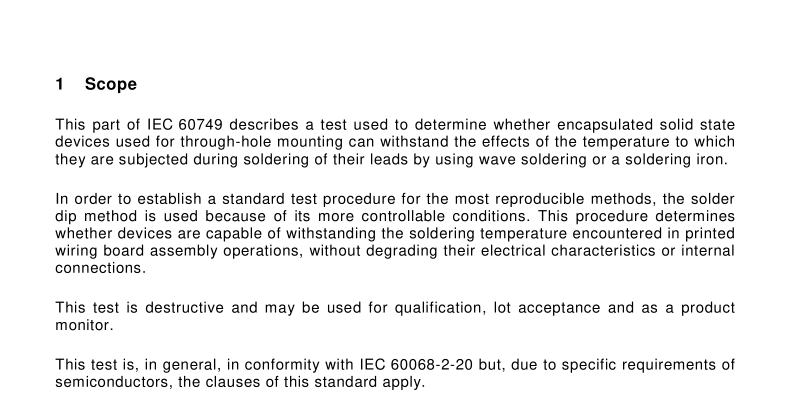IEC 60749-15:2010 pdf download – Semiconductor devices – Mechanical and climatic test methods – Part 15: Resistance to soldering temperature for through-hole mounted devices
1 Scope
This part of IEC 60749 describes a test used to determine whether encapsulated solid state devices used for through-hole mounting can withstand the effects of the temperature to which they are subjected during soldering of their leads by using wave soldering or a soldering iron. In order to establish a standard test procedure for the most reproducible methods, the solder dip method is used because of its more controllable conditions. This procedure determines whether devices are capable of withstanding the soldering temperature encountered in printed wiring board assembly operations, without degrading their electrical characteristics or internal connections.
This test is destructive and may be used for qualification, lot acceptance and as a product monitor. This test is, in general, in conformity with IEC 60068-2-20 but, due to specific requirements of semiconductors, the clauses of this standard apply.
2 General
The heat is conducted through the leads into the device package from solder heat at the reverse side of the board. This procedure does not simulate wave soldering or reflow heat exposure on the same side of the board as the package body.
3 Test apparatus
3.1 3.2 3.3 Solder pot A solder pot of sufficient size to contain at least 1 kg of solder shall be used. The solder pot dimensions shall allow full immersion of the leads without touching the bottom. The apparatus shall be capable of maintaining the solder at the temperature specified in Table 1 .
Dipping device A mechanical dipping device shall be used that is capable of controlling the rates of immersion and emersion of the leads and providing the dwell time as specified in Table 1 . Heatsinks or shielding If applicable, heatsinks or shielding shall be attached to the devices prior to the test and shall be as specified in the relevant specification.
4Materials
4.1Solder
The solder specification shall be as follows.
Chemical composition
– for SnPb solder the composition in percentage by weight shall be as follows:Tin:59 % to 65 %;
Lead:the remainder.Chemical composition
– for Pb-free solder the composition in percentage by weight shall be as follows:
Silver:3 % to 4 %;
Copper: 0.5 % to 1 %;Tin:the remainder.
The solder shall not contain impurities which will adversely affect its properties.
Other solders and their applicable bath temperatures may be used as specified in the relevantspecification.
4.2Flux
lf flux is applied prior to solder dipping, the flux shall consist of 25 % by weight of colophonyin 75 % by weight of isopropyl alcohol, unless otherwise detailed in the relevant specification.”
5 Procedure
5.1 Pre-conditioning of specimens
Any special pre-conditioning of the specimens prior to testing shall be as specified inthe relevant specification.This preparation may include operations such as bending or otherrelocation of leads, and the attachment of heat sinks or protective shielding prior tosolder dipping.
5.2Preparation of the solder bath
The molten solder shall be stirred to assure that the temperature is uniform.The dross shallbe skimmed from the surface of the molten solder just prior to dipping the part.
